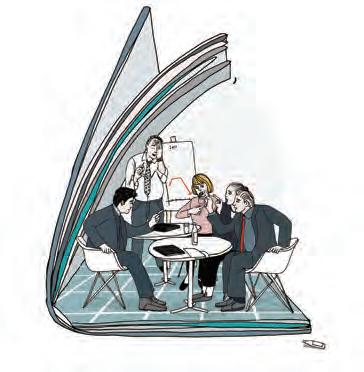
4 minute read
Ben Dattner
from TWSM#7
Book Selection
The Blame Game
Advertisement
How the Hidden Rules of Credit and Blame Determine Our Success or Failure
By Ben Dattner
twsm From your experience(s), how can having a bad employee dynamic (people who take false credit or play the blame game) influence a company’s success?
bd Just like the economic credit cycle, “credit” cycles within organizations can either lead to growth or contraction in the level of “trade” and collaboration between individuals, teams, departments, and divisions. People at any level of any kind of organization struggle when the dynamics of blame take over, and contagious negative influences cause people to become more focused on casting or denying blame for problems than on fixing them. In other words, there is a direct correlation between how people give one another credit (or blame) and whether the pie expands or contracts as everyone tries to claim his or her own slice.
twsm Can the constant behavior of blaming others unfairly become selfdefeating and/or damaging for your colleagues? Why?
bd There is much research evidence that people who blame others too much or too often are more likely to derail in their careers. Although it may be tempting in the short term to take too much credit, and not take any blame, this prevents learning and success over the long term. First of all, if you are too biased and self serving when it comes to credit and blame, you are much less likely to develop a true picture of your own talents, knowledge and capabilities. If you lack accurate self-awareness, you will not be able to build on your true strengths and remedy your areas for development. Secondly, if you develop a reputation among colleagues for being too self-serving when it comes to credit and blame, they will soon come to resent you, will stop collaborating with you, and will withhold the “discretionary” assistance that you will need in order to achieve success in a collaborative manner.
twsm During your research what types of cases of companies being compromised by blaming games did you find?
bd In my book, I tell the story of a chain of retail stores where a team was in charge of selecting locations for new stores to open. However, when the team fell behind schedule, it became more focused on blaming and scapegoating one individual member of the team than on getting its work done. When individuals, teams and organizations get caught up in the blame game, they focus more on finger pointing than on problem solving. Ultimately, this contagious negative dynamic impacts everyone in the organization and creates a negative, self-fulfilling cultural pattern.
twsm How important is the role of the leader in avoiding creating bad dynamics among the staff?
bd Leaders don’t just manage organizations, they also manage cultures and hidden economies of credit and blame. Patterns of credit and blame in a workplace can either foster organizational growth, evolution and learning or cause companies to stagnate and devolve into dysfunctional politics and finger pointing. Leaders at all levels set the tone for how credit and blame get assigned within an organization, and they do so knowingly or unknowingly, and for better or for worse. Great bosses create and sustain teams and organizations in which “credit” expands, meaning that people are willing to exert discretionary effort on behalf of others, with the good faith expectation that these positive and proactive moves will be acknowledged and reciprocated. Successful organizations and leaders leverage credit and blame in a positive manner by fostering commitment, cohesion and trust among the members of the organization. •
Brian Tracy.
Full Engagement! Inspire, Motivate, and Bring Out the Best in Your People [Amacom, pp 256, $22.00] Tracy presents a new method of management that can lead to high financial profits for a company. The key is ROE, which stands for “return on energy” physical, mental and emotional. He explains managers are motivated and influenced by the same things other people are, they already know everything they need to know to unlock the potential of the people around them. They just need to apply it. Using this method, managers can maximize the company’s outcome and have a workplace that makes a difference in the lives of their employees.
Doug Russell. Succeeding in the
Project Management Jungle. How to Manage the People Side of Projects [Amacom, pp 272, $19.95] This book presents the best way to survive the Project Management Jungle, which is Russell’s trademarked system of TACTILE Management (Transparency, Accountability, Communication, Trust, Integrity, Leadership and Execution results), a people-based approach and promotes teamwork. Project managers also need to understand the expectations of key stakeholders. Basically this means balancing the “Triple Expectations Pyramid” which balances the expectations of the customers, management and team with the schedule, cost and performance requirements.










